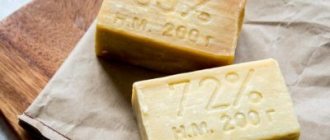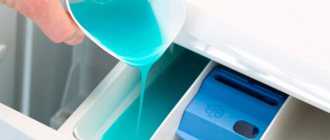Main differences
The main difference between powders intended for hand and machine washing comes down to their ability to form foam.
If a person washes by hand, then it is important that the composition foams well . The higher this indicator, the better the item will be cleaned. It is the foam that helps knock out various contaminants from the fabric fibers.
Machine wash powder, on the other hand, should not produce a lot of foam. If there is too much of it, it can damage the machine and lead to poor wash quality.
During operation of the device, the drum lifts the laundry upward, from where it falls down, hitting the water. If there is a lot of foam, then it will not allow things to move freely through the centrifuge , which will affect the quality of the wash.
Excessive suds can seep through the gaskets, increasing the risk of shorting out electronics, so this wash is especially dangerous for front-loading appliances.
Foam is not the only difference between the powders; there are other differences as well. What is the difference between the powders:
- Compound. Automatic powders contain special components that soften the water and prevent the appearance of sediment when it is heated.
Hard water leads to the formation of scale on the elements of the washing machine, which is why it quickly fails. Moreover, the automatic powders do not contain aggressive components, such as solvents or chlorine bleaches, that can harm the device. Manufacturers often supplement the composition of hand wash products with components designed to care for the skin and protect it from the influence of chemicals. - Dissolution rate . Compositions intended for automatic washing have a higher concentration, so they need to be used in smaller quantities, and they will take longer to dissolve.
- Price. If you pay attention to the price, hand wash products are about 20-30% cheaper.
You should not be afraid of the soap contained in the automatic powder. It will not harm the washing machine.
Comparison
When choosing a washing powder, you should pay attention to the inscription on the packaging: “for hand washing” or “automatic”. A mistake or a desire to save money can lead to the fact that the washing machine will have to be repaired or even bought a new one. The thing is that hand washing powders are characterized by increased foaming, while automatic washing powders contain special defoamers (foam stabilizers), which do not allow the foam to exceed the level permissible for an automatic washing machine. This was done to prevent foam from creeping out from under the drum cover and powder compartments, from clogging the machine hoses, and from getting into the electric motor.
In addition, automatic washing powder and hand washing powder have several more differences:
| Powder machine | Hand wash powder | |
| Additional substances | May contain calgon - a product that softens hard water and prevents the appearance of scale on important parts of the washing machine. Does not contain solvents and chlorine (the latter is harmful to the rubber parts of the washing machine) | May contain hand care products and soap. The latter component is often included in baby laundry detergents. |
| Dissolution rate | Takes longer to dissolve than hand wash powder. Automatic powder is more concentrated | It is recommended to wash clothes after the granules have completely dissolved in water, which occurs quite quickly. |
| Washing quality | A deterioration in the quality of washing is typical when the amount of washing powder is increased/decreased. It is necessary to pour the amount of powder indicated on the package | The quality of washing largely depends on its intensity (on the work of the hands) and thorough rinsing. Having poured more powder, you will need to rinse things longer than usual |
Is it possible to pour hand-washing compounds into the washing machine?
Hand wash products should not be used in the washing machine.
Why not and what will happen? Excessive foam will cause the electronics to incorrectly detect the water level , which may cause it to malfunction.
The abundance of foam negatively affects the functioning of the heating element. If it gets on the heating element, it may break. There is also a risk of damage to the motor and control unit.
What to do if the cycle has already started?
If a non-target powder was accidentally poured into the machine and the cycle has already started, most often nothing bad happens . If the standard doses are observed, the processing of the laundry will be completed successfully, but next time you need to be more careful in choosing the composition.
However, if too much powder has been used, or things that cause excessive foam formation are loaded into the drum, it may come out through the top. In such a situation, urgent measures need to be taken.
Procedure:
- The device is paused.
- Select the water drainage program.
- Empty the drum and rinse things by hand.
- Start a new cycle using a suitable product.
If the machine shorts out, you need to turn off the power and call a technician.
Conclusions TheDifference.ru
- The automatic powder contains special defoamers that prevent the formation of excess foam, which can seriously damage the washing machine.
- The composition of the automatic powder may include calgon. The machine does not contain solvents or chlorine. Hand washing powder contains hand care products and, in some cases, soap.
- The granules of the automatic powder take longer to dissolve, and it is more concentrated.
- Automatic powder is characterized by a deterioration in the quality of washing if the amount of detergent is incorrectly dosed.
Should I use automatic powder for hand washing?
If you don’t have hand washing powder on hand, you can replace it with an “automatic” one. In this case , a little less product will be required, since its concentration is higher .
First you need to pour the granules into a bowl, then fill it with water and thoroughly stir the composition until completely dissolved. This will require more effort and time.
You need to be prepared for less foam to form. However, this will not affect the quality of washing. Hands must be protected with gloves so as not to dry them out and cause irritation.
It is not advisable to use automatic powder for hand washing. It costs more, and you will have to put in more effort for quality washing.
All the most important and useful information about washing powder is in this section.
Definition
Automatic powder is a powdered detergent that is intended for washing clothes in an automatic washing machine.
Hand wash powder is a powdered detergent intended for hand washing. Also suitable for activator-type washing machines, in which you need to fill the water yourself and then manually rinse the laundry.
All powders are classified as household chemicals.
Which powder is better to choose?
There are a lot of opinions regarding the question of which powder is best for dealing with stains. But one way or another, you should choose the one that has already been tested and will be the safest for fabrics and skin. The first thing an experienced housewife focuses her attention on is the composition of the powder . The less phosphates it contains, the better it is.
Some products are designed specifically for certain fabrics, for example, wool and cotton are called biopowders. Thanks to them, things do not stretch or fade. They are also good for removing stains of blood, fat, eggs, dairy products or protein products.
Special enzymes work to dissolve protein compounds and other dirt. But at the same time, enzymes do not always help to effectively combat pollution, if you do not take into account the correct use of them. It means that enzymes are not very resistant to high temperature hot water, and therefore should be no more than 50 degrees .
Speaking about the use of high concentrations of enzymes, we can conclude that they do not dissolve well in water and after washing, protruding stains are noticeable. Powders containing enzymes are well suited for cleaning fabrics in cool, low-temperature water. It is recommended to wash children's clothes with products that contain silver. It is its particles that successfully disinfect bacteria and do an excellent job of removing dirt.
Detergent concentration
The effectiveness of stain removal depends on this indicator. Basically, in all detergents, this function is performed by surfactants (surfactants), which can be anionic and non-ionic.
The first act on the surface of the fabric. The latter penetrates into the fibers. The amount of these substances in the powder determines the degree of its concentration. The content of surface dirt removers can range from 5 to 15 percent, and more aggressive interstitial substances should not exceed 5 percent.
Another substance responsible for removing stains is enzymes. These are active protein compounds that have the ability to destroy other proteins. But at temperatures above 40 degrees, they themselves begin to disintegrate, since they are a biological compound. Therefore, they are most often used in powders for colored fabrics.
Automatic powder is more concentrated. Detergent manufacturers are forced to increase the concentration of active substances to ensure better washing quality. After all, you are loading not just one item into the washing machine, but several kilograms of dirty laundry, and you can only use a limited amount of powder. To cope with all the contaminants and return things to cleanliness, we had to make the automatic powders more aggressive.
According to the Russian standard (GOST 22567. 5-93), the concentration level of hydrogen ions must correspond to the range from 7.5 to 11.5%. The closer the indicator is to a lower value, the better - your laundry will wear out less during washing.
Foaming
This is the ability of a substance to produce foam. It is the main criterion by which two types of powder are separated. It's all about the difference between washing methods by hand and using technology.
When washing by hand, it is important that the powder foams well. The presence of abundant foam greatly facilitates the washing process, as it reduces friction and helps draw dirt out of the fabric.
In the machine, the drum, using centrifugal force, lifts the laundry to the highest position, and then it falls down under the influence of gravity and its own weight. As a result of hitting the water, dirt and excess soap are removed from things. If the foam is abundant, it will soften the blow and the laundry may not be washed. Also, such an “abundance” is fraught with the leakage of a foamy substance through the cracks of the gaskets and a short circuit of the machine.
Another criterion by which the foaming process is assessed is foam stability. For hand washing powders it is also significantly higher than for its washing machine counterpart. According to GOST, the height of the foam should not exceed 20 cm, even for non-automatic powders.
Results of using powders after washing
The quality of washing powders for hand and auto washing is very noticeable. In the first case, it all depends on the amount of powder . This is characterized by deteriorated washing quality, which depends on increased or decreased powder consumption. Excessive consumption of powder will only result in excess product consumption.
You need to pour exactly as much as indicated on the package. The emphasis is on hand efficiency and rinsing. If you use car wash powder, there will be much more foam, stains will be removed worse and, accordingly, you will need to rinse longer.











